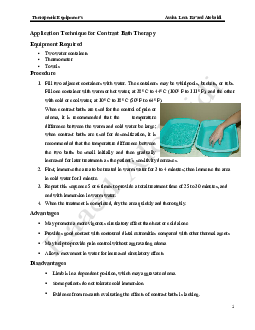

Preview text:
lOMoARcPSD|36041561
Therapeutic Equipment’s Assist. Lect. Ra’aed Alobaidi
Phonophoresis Application Technique
Phonophoresis is a technique in which ultrasound is used to enhance
the delivery of a selected medication into the tissues.
The medication can be delivered via a safe, painless, noninvasive technique.
Active transport occurs as a result of both thermal and non-thermal
mechanisms that together increase the permeability of the stratum
corneum, although using thermal parameters seems to be most beneficial.
This allows the medication to diffuse across the skin because of
differences in concentration from the outside to the inside.
Medications commonly applied through phonophoresis most often are either
anti-inflammatories such as hydrocortisone, cortisol,
salicylates, or dexamethasone or analgesics such as lidocaine.
Pathways of drug penetration 1. Through stratum corneum 2. Trans follicular 3. Through the sweat glands
Because research has shown some of these medications
to impede the ultrasound, one suggestion is to apply the medication and gel separately.
This is accomplished by rubbing the medication directly onto the surface of
the treatment area and then applying gel followed by the application of ultrasound.
With the direct technique, transmission gel should be applied, and with
immersion, the treatment area with the preparation applied is simply treated underwater. Raaed Alobaidi
Both pulsed and continuous ultrasound has been used in phonophoresis.
Treatment Protocols: Phonophoresis
1. The therapist should remember that most of the medications used in
phonophoresis must be prescribed by a physician.
2. You must ask the patient if he or she has any allergies to medications and
document his or her response in the patient’s chart.
3. Cleanse treatment surface with alcohol or soap and water.
4. Apply medication in glycerol cream, oil, or other vehicles in lieu of coupling gel. 1
Downloaded by Nga T??ng (ngahuong55@gmail.com) lOMoARcPSD|36041561
Therapeutic Equipment’s Assist. Lect. Ra’aed Alobaidi
5. Establish treatment duration dependent upon size of area to be treated (i.e.5
minutes for each 40 –cm2 area).
6. Maintain contact between soundhead and treatment surface, moving
soundhead in circular or linear overlapping strokes at a rate of 5–10cm2/sec;
observe for air bubble formation.
7. Adjust treatment intensity: 0.5–1.0 W/cm2 for superficial tissues and 1.0–2.0
W/cm2 for deeper tissues. Intensity may need to be decreased.
8. Monitor patient response during treatment; if the patient reports warmth or
ache, reduce intensity by 10% and continue treatment.
9. Cleanse treatment surface with alcohol or soap and water.
Clinical Application of Phonophoresis Drug Indication Reactions/ contraindications Hydrocortisone Anti-inflammatory Skin rashes Lidocaine / Acute pain xylocaine Methyle salicylate Chronic painful MS disorders Sensitivity to aspirin Zinc oxide/ Open wounds Allergy to metals siloderm Iodine
Adhesion, calcification, Allergic to sea food adhesive capsulitis Raaed Alobaidi 2
Downloaded by Nga T??ng (ngahuong55@gmail.com)




